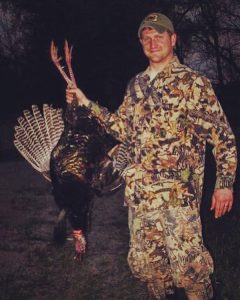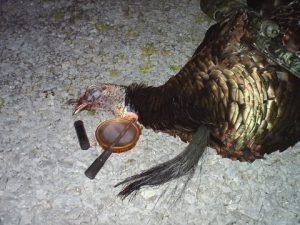By Adam Crews
Throughout the turkey season, it can be difficult to know if you’re hunting the same gobbler. Often, gobblers will look similar in size and at times even run in the same bachelor groups. But some birds carry distinct characteristics and behaviors—such is the story of the Pond Turkey.
My first encounter with the Pond Turkey was on a juvenile hunt. The bird had gobbled on the roost above the pond, which laid in the center of the farm, he pitched down into a field and strutted onto an adjacent farm the rest of the earlier morning hours. About mid-morning, my brother and I, set up on the edge of the field where we displayed a full-strut decoy and one hen in the opposite direction this bird had gone.
Ten minutes had passed since our first calling sequence, and we hear a thunderous gobble erupt a mere 30 yards behind us. At the edge of the treeline, we observe the reddest headed bird ever to walk the face of the earth. His face was such a color red that is was almost demonic in appearance. That turkey looked as though he would and could whip any animal that presented a challenge, much less another gobbler. Again, he trotted out of our life as he knew something wasn’t right with the situation.
We decided to take a break for lunch, so we began the walk back down the hill, back towards the pond, and towards our truck for a lunch break. As we approached the pond, I decided to give the woods one more round with my crow call. Hoping that I might shock some gobbler into life, I let out a call and immediately and received an immediate response. We had no time to think or react, we hit the ground, laid on our bellies and I made one soft series of yelps followed by some hard cuts. The same red-headed evil looking gobbler appeared from over the ridge at 30 yards, stuck up his neck and my young-hunter rang out a shot that didn’t connect.
As that season went on I encountered this bird on almost every trip, but I could never get in front of him, and calling to him was a fool’s errand. He went for an extended period without ever letting out another gobble and finally the season closed. I figured that would be it, that would be our history.
Redemption
 The following season I was greeted by a pleasant surprise—the same red-headed bird had roosted above the pond. The Pond Turkey would gobble some this year, but very little. Yet every day he’d show back up in his roosting area.
The following season I was greeted by a pleasant surprise—the same red-headed bird had roosted above the pond. The Pond Turkey would gobble some this year, but very little. Yet every day he’d show back up in his roosting area.
Finally, I made the decision I was going to do what it took to kill this bird. Late one afternoon, I tucked away into the treeline of his core area with one call in my pocket and not a lot of confidence.
I sat down, made one series of soft yelps and started scratching in the leaves. Almost immediately a hen responded in a way that meant business. I could have never guessed what would happen next—the hen comes out of nowhere in the shadows of the standing of oak trees. She is on a dead sprint towards my location, head bobbing, cutting, looking for a fight. Behind her, following closely, I see the red-headed Pond turkey—his long and full beard flopping side to side as he approached my tree.
After two years of letting this bird get the best of me, it finally came to an end. It’s no surprise that I didn’t fool this bird, nor did I call him in, or even outsmart him. He was apparently love-struck and out of his senses at that moment—which was the perfect ending to our story together.
